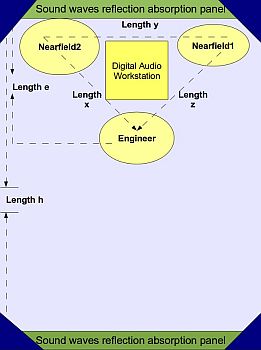One of the most challenging things in audio mixing is to make your mix sound better when it’s played outside of your mixing control room. It can be in your bedroom hi-fi system, iPod, mp3 players, car stereo or even in radio and television.
The objective in mixing is to have a mix that sounds good both in your control room and in the outside. This post will list down all the tips that I know that can make your mix translate better to different audio systems.
The Basic Gears that you should have
1.) Use nearfield monitor – this reference monitor is designed to reproduce flat and accurate frequency response of the audio being analyzed. So if you are mixing with your computer hi-fi speakers; then its time to stop it now and switch to nearfield monitor.
2.) Proper acoustic room treatments – this is a very broad topic, but can be depicted in a single screenshot below:

The sound waves reflection panel is usually made of fiber glass as well as the bass trap (in blue). For details, read this post in home studio setup and acoustic design.
3.) Quality Audio Interface – traditional PCI soundcard cannot be relied for accurate monitoring because they are created for gaming and other applications except professional audio. Get a USB or Firewire audio interface designed for these applications.
Evaluating Room Response for Accurate Mixing
It is not just enough to put those fiber glasses everywhere in your room and then it’s done. Make sure you will evaluate the accuracy of your room response.
This is my favorite test:
a.) Sit at the mixing position (center of the equilateral triangle facing the nearfield monitors). Refer to the engineer position on the above screenshot.
b.) Turn off any obvious noise sources in your room (air condition, etc).
c.) Execute this test by playing this MP3 file. Test tone courtesy of M-audio
Feel free to adjust the volume first so that the loudest peak is enough for you to listen. Do not monitor too loudly with these test tones. This is a test tone with range from 20Hz to 20 KHz. Of course if your nearfield monitor can only go down as deep as 50Hz then expect the bass to start appearing at 50Hz. Once the bass is clear or significant, the volume should be EVEN throughout the test tone until 20 KHz. If its not even; for example the bass response is weak compared to the mid and high frequencies then the room response is still not flat. You still need to examine what went wrong with your acoustic treatments. Other similar problematic scenarios:









No responses yet